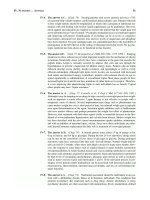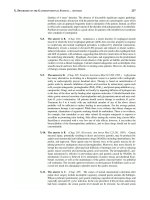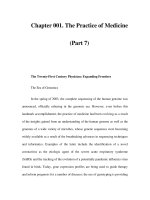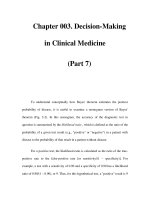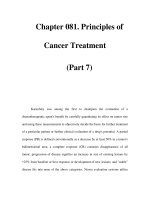The Gist of Emergency Medicine - part 7 doc
Bạn đang xem bản rút gọn của tài liệu. Xem và tải ngay bản đầy đủ của tài liệu tại đây (58.68 KB, 19 trang )
The Gist of Emergency Medicine
Pediatrics (second of two sections)
115
→ shaken baby syndrome → coma/seizures, ± retinal hemorrhages, ± new or healing rib/extremity fractures, ±
other injuries.
→ Munchausen’s by proxy, e.g. apnea spells, sepsis, poisoning.
→ bruises → red-blue (1 day old) → green (5 days) → yellow (7 days) → brown (10 days)
→ remember that mongolian spots or folk remedies may simulate bruises.
→ coagulation studies?, skeletal survey?, CT scan?, MRI?
→ parent/caretaker volunteers that they were abused as a child?
L ACBC’s, supportive care, rule out legitimate injuries/illness, e.g. accidental burns, leukemia; treat other
problems, e.g. injuries, STD (sexually transmitted disease); pregnancy test/prophylaxis prn (ovral
®
prn),
colposcopy/forensic examination prn (photos prn), child protection, appropriate reporting, counseling,
admit prn.
→ postscript → society continues to pay an ever increasing price (e.g. violence, substance abuse, family
discord, and other dysfunctional behaviours), for the inappropriate care, neglect, and abuse of its children
(my impression).
(16) Seventeen
→ beware of entrapment/tourniquet injuries of the penis and digits in infants (e.g. hair, clothing material).
The Gist of Emergency Medicine
Endocrinology and Hematology
116
XI. ENDOCRINOLOGY AND HEMATOLOGY
(1) Unexplained? hypoglycemia
→ Pancreatic or other tumors?, drugs?, e.g. alcohol; endocrine disorder?, e.g. myxedema; surreptitious
administration of insulin or oral hypoglycemic agents?
→ seizures?, coma?, confusion or bizarre behaviour?
→ do a serum glucose, a serum insulin, insulin antibodies, and c-peptide levels prn.
L ABC’s, I.V. dextrose prn → 5, 10, 25, or 50% prn, glucagon 1-5mg I.V. prn, Solu-cortef
®
250mg I.V. prn,
and diazoxide 300mg I.V. prn over 30minutes. Treat other problems, e.g. hypothyroidism. Alcoholics
require thiamine 100mg I.M./I.V.
→ hypoglycemia may simulate a CVA, especially in the elderly (including focal deficits).
→ ketotic hypoglycemia can occur in children 1-5 ± years of age.
Oral hypoglycemic agents → beware of prolonged hypoglycemic effect (hours, days).
(2) Diabetic ketoacidosis (DKA)
→ undiagnosed diabetic?
→ hyperglycemia, dehydration, electrolyte loss, and metabolic acidosis.
→ kussmaul breathing?, vomiting?, coma?, shock?, other problems?, e.g. pneumonitis, trauma. Preexisting
medical problems?, e.g. chronic renal failure plus DKA may result in life threatening hyperkalemia.
→ L ABC’s, I.V. fluids/lytes (K
+
prn, bicarbonate prn, NaCl prn {saline, ringers}, phosphate?, Mg?, Ca?),
low dose I.V. insulin drip, and L precipitating cause, e.g. UTI, MI, trauma. Use a flow sheet (assessments,
investigations {e.g. blood gases, lytes, glucose}, and therapeutic measures).
→ Admit ICU prn → the patient may require invasive monitoring, e.g. history of CHF.
→ Give boluses of normal saline/ringers for dehydration/shock (20mL/kg in children).
→ Add 40meq KCl/liter to 0.5-N saline once urine output begins (if not hyperkalemic), or before if the T
waves are flat (serum K
+
pending) or the serum K
+
is low.
The Gist of Emergency Medicine
Endocrinology and Hematology
117
→ Beware of an initial hyperkalemia, e.g. concomitant acute or chronic renal failure (peaked T waves and
wide QRS) → emergency L prn → sodium bicarbonate 1meq/kg/I.V. prn, calcium gluconate 10% 5-10mL
I.V. prn (0.2mL/kg in children), bolus regular insulin 10 units I.V. (0.1 unit/kg in children), and bolus
normal saline 1-2liters (20mL/kg in children).
→ give sodium bicarbonate 1-2meq/kg I.V. prn for pH < 7.1 (over 2-2 hours, no I.V. push except if the
patient is critical: caution → be on the alert for hypokalemia, hypomagnesemia, and paradoxical cerebral
acidosis/edema).
→ replace ½ of the fluid (+ maintenance), and electrolyte deficits over the 1
st
8-12 hours (after the initial saline
boluses prn). The total deficits may be Na 9 mEq/kg, K
+
2-6 mEq/kg, and fluids 100mL/kg. The patient
may also require MgSO
4
, calcium, or phosphate. See also #(17)-(22), pp. 62-64.
Regular insulin (low dose I.V. drip)
L children → 0.1unit/kg/hr/I.V.
adults → 5-10units/hr/I.V.
→ also give an initial I.V. bolus of insulin equal to a one hour’s dose.
When serum glucose is reduced to 250mg (14mmol/L), add dextrose to I.V., and continue I.V. insulin until
acidosis clears, then give insulin/sliding scale s.c. (as follows).
SLIDING SCALE REGULAR INSULIN qid s.c.
serum glucose insulin (dose may vary)
5 - 10 mmol/L (90 - 180mg/100mL) L 2-4 units s.c.
10 - 15 mmol/L (180 - 270mg/100mL) L 4- 6 units s.c.
15 - 20 mmol/L (270 - 360mg/100mL) L 6- 8 units s.c.
20+ mmol/L (360
+
mg/100mL) L 8-10 units s.c.
(3) Alcoholic ketoacidosis
→ hyperventilation, dehydration, electrolyte loss, metabolic acidosis.
L ACBC’s, thiamine, 50% dextrose prn, D5ringers, bicarb?, phosphate?, and treat other problems, e.g.
pancreatitis, alcohol ± other drug withdrawal.
The Gist of Emergency Medicine
Endocrinology and Hematology
118
(4) Lactic acidosis
→ hyperventilation, weakness, otherwise unexplained high anion gap (e.g. salicylates), lactic acid ≥
7mmol/L. Methanol poisoning?
L ABC’s, I.V. fluids, bicarb prn to pH 7.2
+
(careful: paradoxical CSF acidosis, hyperosmolality);
hemodialysis prn, and L underlying cause, e.g. sepsis, near drowning.
(5) Nonketotic hyperosmolar coma
→ underlying heart or renal failure?
→ weakness, dehydration, confusion to coma.
L ABC’s, I.V. fluids/lytes (substantial loss), low dose I.V. insulin drip, and L precipitating cause, e.g. CVA,
pneumonitis. See also #(2), p.116.
(6) Thyroid storm
→ signs of thyrotoxicosis, plus fever, dehydration, and cardiovascular, CNS, and GI dysfunction (beware of
apathetic hyperthyroidism in the elderly).
→ initial blood work (e.g. T3, T4, free thyroxin, cortisol).
L ABC’s, supportive care, I.V. fluids/lytes, 50% dextrose prn, multivitamins prn, cooling/Tylenol
®
prn (no
ASA), treat the precipitating cause (e.g. pyelonephritis), and specific treatment, as follows, L:
1. Propylthiouracil (inhibits thyroid hormone synthesis, and T4 → T3 conversion) → 900-1200mg po stat
→ 300mg q6h prn
→ then 300-600mg/day X 3-6 weeks.
2. Iodine solution (blocks hormone release) → start 2 hours after the propylthiouracil has been given → 30
gtts po/day X 10-14 days.
3. Inderal
®
(beta blockade) 1mg I.V. prn, to total of 10mg
→ 20-120mg q6h po (blocks thyroxin’s peripheral effects, and T
4
to T
3
conversion).
4. Solu-cortef
®
250mg q6h I.V. for “stress”, also blocks thyroxin release, and peripheral T
4
to T
3
conversion.
The Gist of Emergency Medicine
Endocrinology and Hematology
119
5. Plasmapheresis prn, dialysis prn, RAI (later prn).
→ patient requires admission to ICU.
(7) Myxedema coma
→ manifestations of hypothyroidism, plus CNS, respiratory, cardiovascular, and metabolic dysfunction. The
elderly may have an atypical presentation.
→ do routine bloodwork, EKG, chest x-ray, plus T
4
, T
3
, TSH, and cortisol levels.
→ you may have to initiate specific L before laboratory confirmation.
→ L ABC’s and supportive care, 50-100% O
2
prn, 50% dextrose prn, ringers prn, Solu-cortef
®
100-500mg
q4-6h I.V., thyroxin 500µg I.V. (after the initial dose of Solu-cortef
®
), then 100µg I.V. daily. Treat any
other problems (e.g. hypothermia, hyponatremia), or precipitating cause, for example, pneumonitis, UTI.
Caution with underlying heart disease, L of hypothyroidism may precipitate CHF/angina/MI. ICU
admission is required.
(8) Adrenal crises
→ abrupt cessation of prednisone therapy?
→ sepsis?/anticoagulant therapy?/adrenal hemorrhage?
→ lethargy, fever, shock, nausea, vomiting.
→ the diagnosis of subacute adrenal failure is often missed, or delayed.
→ order routine bloodwork, plus ACTH and cortisol levels (also do ACTH testing if appropriate).
→ L ABC’s, D5saline boluses prn, bicarb prn for hyperkalemia, Solu-cortef
®
500mg I.V. (initial dose),
dopamine prn, and treat any precipitating cause that may have converted a chronic adrenal insufficiency
into an acute crises, e.g. pneumonitis, trauma.
(9) Nine
(A) Platelets
→ ABO matching is not required → 10 packs of platelets will raise the platelet count by approximately
40-50,000, children L 0.2 packs/kg body wt.
The Gist of Emergency Medicine
Endocrinology and Hematology
120
→ platelet count greater than 50,000 is OK; less than 20,000 is critical, e.g. substantial risk of CNS
hemorrhage.
→ follow with frequent platelet counts prn. See #(11), p.120.
(B) Fresh frozen plasma
→ ABO matching is required: contains all the clotting factors (1 unit/cc).
(C) Cryoprecipitate
→ no ABO matching is required: contains factor 8, fibrinogen (5-10units/cc), and Von Willebrand’s factor.
Normal fibrinogen levels = 200-400 mg/dl. Caution: can your blood agency assure the safety of their
cryoprecipitate? (e.g. HIV, HB, HC).
(10) Hypoprothrombinemia
→ e.g. excessive warfarin therapy → L vitamin K 2.5-25mg po/s.c./I.M. → repeat prn. Caution: I.V.
vitamin K has reportedly resulted in anaphylactoid like reactions, and death.
(11) ELEVEN
(A) Idiopathic? thrombocytopenia purpura
→ acute?, chronic?; DIC?, drugs? (e.g. antibiotics), infection? (e.g. infectious mono), alcohol? (resolves
with abstinence?), AIDS?, neoplasm?, collagen disease?, transfusion reaction?, idiopathic?
→ L ABC’s, platelets prn, immune globulin prn, steroids prn, L any underlying cause.
→ platelets (10 packs/adults) may have to be given before and after the initial dose of the immune globulin
(400-1000mg/kg/I.V.). Frequent platelet counts prn. See #(9), p.119.
(B) Thrombotic thrombocytopenic purpura
→ thrombocytopenia, hemolytic anemia, red cell fragmentation; systemic, neurological, and renal
manifestations.
L ABC’s, plasmapheresis, platelets prn, prbc’s prn.
→ early intense plasmapheresis can be crucial for patient survival.
The Gist of Emergency Medicine
Endocrinology and Hematology
121
(C) DIC (Disseminated Intravascular Coagulation)
→ may have an acute or subacute presentation
→ DIC screen: platelet count, PT, PTT, fibrinogen, fibrin degradation products.
L ABC’s, treat the precipitating cause (e.g. sepsis, trauma, shock, burns, heat stroke, head injury,
transfusion reaction, cancer, obstetrical problems), I.V. heparin prn, PRBC’s prn, FFP or cryoprecipitate
prn, and platelets prn. Fibrinogen should be kept above 150mg/dL (15 bags of cryoprecipitate →
approximate increase of 100mg/dL in the fibrinogen level), and the platelet count kept above 50,000 (10
packs platelets → an increase of 40-50,000 in the platelet count/children 0.2 packs/kg body wt). Caution:
See also Cryoprecipitate, #(9)(C), p. 120.
(12) Hemophilia
L ABC’s, local pressure ± local thrombin prn, desmopressin (DDAVP) 0.3µg/kg I.V. prn (for hemophilia
A, or type I von Willebrand’s disease, consult references), factor VIII/IX concentrate prn, cryoprecipitate
18-45units/kg q8-12h prn, up to 80 units/kg prn with intracranial bleeding, or serious trauma, (circulatory
factor VIII/IX inhibitors present?).
→ Fresh frozen plasma (FFP) may be used, but may result in volume overload.
→ give prophylactic factor VIII/IX concentrate prn with head injury or major trauma.
→ also ice packs, ace bandages, splinting, analgesics (I.V. narcotics?), and steroids prn.
→ hemophilia occurs in males only, von Willebrand’s disease occurs in both sexes.
→ Caution: See also Cryoprecipitate, #(9)(C), p. 120.
(13) THIRTEEN
(A) Autoimmune hemolytic anemia
→ etiology, for example, drugs, collagen diseases, infectious mono, mycoplasma infection, mushroom
poisoning.
L ABC’s, prednisone/solu-cortef
®
prn, PRBC’s prn, treat the underlying problems, e.g. discontinue
causative drugs.
The Gist of Emergency Medicine
Endocrinology and Hematology
122
(B) Sickle cell crises
→ thrombotic, hemolytic, aplastic, or splenic sequestration crises; sepsis, and acute chest syndrome.
L ABC’s, 50-100% O
2
prn, analgesics prn (I.V. narcotics?), I.V. fluids prn, PRBC’s prn (partial exchange
transfusion?), and folic acid (5-20
+
mg daily). Treat infection (salmonella septic arthritis?), and metabolic
acidosis if present. Beware of drug addiction and drug seeking behaviour. Autosplenectomy?
(C) Acute leukemia
L ABC’s, supportive care: beware of infection, thrombocytopenia, and DIC. Refer immediately.
(D) Infectious mononucleosis
→ beware of upper airway obstruction, encephalitis, hepatitis, thrombocytopenia, and splenic enlargement
(may rupture from minor trauma).
L ABC’s, supportive care, analgesics/antipyretics prn, prednisone prn, platelets prn. Avoid contact sports
with splenomegaly. Concomitant strep. infection?
→ infectious mononucleosis often simulates bacterial tonsillitis.
(14) Massive blood transfusions
→ watch for a decrease in the coagulation factors (give FFP & platelets prn), ARDS (use micropore filters),
hypothermia (warm transfusion products), and hypocalcemia (give calcium gluconate 10% 1-10ml slowly
I.V. prn).
(15) Transfusion reactions
→ febrile reactions (use washed, leucocyte poor, PRBC’s), allergic reactions (e.g. urticaria, anaphylaxis),
delayed reactions (e.g. serum sickness, hepatitis B), or hemolytic reactions. Hemolytic reactions are the
most life threatening, and may result in, for example, anaphylaxis, shock, DIC, renal failure. Using washed
PRBC’s prevents most allergic reactions.
(16) Sepsis in immunosuppressed patients
→ triple antibiotic therapy
L e.g. claforan
®
(cefotaxime) + tobramycin + clindamycin
The Gist of Emergency Medicine
Endocrinology and Hematology
123
→ See also Septic Shock, p. 76.
(17) Emergency complications of malignancy
L for example, upper airway obstruction, pericardial tamponade, thrombocytopenia and hemorrhage,
adrenal insufficiency and shock, acute tumor lysis syndrome, superior vena cava syndrome, acute spinal
cord compression, CNS problems (e.g. seizures), hypercalcemia, SIADH, hyperviscosity syndrome,
granulocytopenia, immunosuppression, infection, opportunistic infection, and sepsis.
→ inadequate pain control is a frequent urgent/emergent problem of malignancy (call your palliative care
consultant prn).
Remember that patients with moderate/severe chronic pain
*
may appear exhausted and depressed, rather
than anxious. Trust the patient’s assessment of the severity of their pain (e.g. zero to ten = none to the most
severe). Like migraine sufferers, patients with chronic pain syndrome or cancer pain may need parental
analgesics for “breakthrough pain.”
Examples of the drugs and treatment modalities used (in combination prn) for chronic cancer pain (e.g.
bone and/or neuropathic pain, and/or visceral pain) are: (1) morphine → regular dosing, plus prn for
breakthrough pain, no fixed upper limit dosage, addiction rare with cancer pain, (2) codeine, (3) NSAIDs,
(4) acetaminophen, (5) amitriptyline, (6) carbamazepine, (7) dexamethasone, (8) antiemetics (e.g.
prochlorperazine, metoclopramide, dimenhydrinate), (9) radiotherapy, (10) chemotherapy, and (11) nerve
blocks. NSAIDs are useful for bone pain; tricyclic antidepressants, corticosteroids, and anticonvulsants are
useful for neuropathic pain.
→ In addition to morphine and codeine, other useful narcotics are: hydromorphone, oxycodone, fentanyl
(may be given transdermally), and demerol
®
(short term only). Do not forget to put the patient on a regimen
of a stool softener and a bowel stimulant. Except for the initial relief of pain (e.g. morphine 10mg plus
gravol
®
50mg plus toradol
®
30mg I.M.), try to avoid giving analgesics via the intramuscular route for
chronic cancer pain.
*
The denial of chronic pain. Editorial by Dr. Robert Teasell. Pain Research and Management. Vol 2, no. 2, summer
1997.
The Gist of Emergency Medicine
Endocrinology and Hematology
124
The Gist of Emergency Medicine
Central Nervous System (second of two sections)
125
XII. CENTRAL NERVOUS SYSTEM (SECOND OF TWO SECTIONS)
→ See also Central Nervous System (first of two sections), p. 77.
(1) Headache
→ new headache?, acute and recurrent?, chronic?, progressive?, level of consciousness?, nausea/vomiting?
(glaucoma?), pyrexia?, meningeal irritation?, focal signs?, photophobia?
→ beware of headaches in young children (neoplasm?)
→ pain in front of the external auditory meatus = fifth cranial nerve, and above the tentorium.
→ pain behind the external auditory meatus = 9, 10, and 11th cranial nerves, and below the tentorium.
Severe migraine
*
(rebound analgesic-induced headache?)
→ first satisfy yourself that this is not an intracranial hemorrhage/neoplasm, e.g. “Are you sure this is your
migraine?” “Yes, I am positive.” → continue your complete assessment.
→ try I.V. stemetil
®
(compazine, prochlorperazine) 10-20mg, or nozinan
®
(methotrimeprazine) 10-25mg, in
500-1000cc ringers over 30minutes, followed by 500-1000cc ringers wide open
†
→ prn benadryl
®
50mg
I.V./I.M. for agitation, or dystonic reactions, or prevention of same.
This stemetil
®'
regimen may also be useful for viral gastroenteritis (some patients say it’s “like
magic”). Stemetil
®
(10-20mg) and nozinan
®
(25-50mg) may also be given I.M.
Another alternative analgesic for severe migraine, or other causes of severe pain (e.g. renal or
biliary colic), is the NSAID ketorolac (toradol
®
) 30mg I.M./I.V. (caution: allergic reactions; GI hemorrhage
↑ elderly). The response to parenteral toradol
®
can vary from remarkable pain relief, to absolutely no pain
alleviation (but decreases the amount of narcotic required?). It is non-sedating, and is particularly useful in
unaccompanied patients, who if discharged, may wish to drive themselves home.
*
Some migraine sufferers complain that they are made to feel like “criminals” in the E.R. (especially if they ask for
Demerol). I must admit that I have eyed some “legitimate” patients suspiciously.
†
A similar regimen using haldol
®
5mg and normal saline has recently been described.
The Gist of Emergency Medicine
Central Nervous System (second of two sections)
126
→ Other examples of non-narcotic L of migraine are: ASA, Tylenol
®
, NSAIDs, gravol
®
, ergotamine
(DHE), sumatriptan
*
, 100% O
2
, nifedipine, I.V. fluids, maxeran
®
, 1mL intranasal 4% xylocaine (cluster
migraine), chlorpromazine, phenergan
®
, dexamethasone → narcotic required?, e.g. demerol
®
I.M. plus
gravol
®
or stemetil
®
or nozinan
®
I.M. Beware of contributing to narcotic addiction and drug seeking
behaviour. Always complete your assessment of the patient, before confronting them with their drug seeking
behaviour (at times, it is very difficult to resist an initial confrontation).
Some emergency departments are attempting to all but eliminate the use of narcotics for the
treatment of migraine headaches. I agree that the use of narcotics should be discouraged, but I can see no
sense in switching the patient who gets the occasional injection of demerol
®
(which works, that’s why they
ask specifically for it), to another medication. If you offer only non-narcotics to this distressed patient, they
may feel that they were coerced
†
into accepting another medication, and should any adverse reaction occur,
they may think, “lawyer.” On the other hand, don’t be an “easy mark” for a narcotic or benzodiazepine
prescription (or injection). The most I give “to go” is 5 tablets from the ER drug cupboard (no prescription),
and refer them to their own physician for reassessment (some patients make a living off selling their
prescribed narcotics/sedatives). In addition, unless contraindicated, prescribe NSAIDs (e.g. ibuprofen
400mg qid prn X 3-5days), to take in combination with the narcotic (prn) or tylenol
®
(prn). This is general
analgesic advice not limited to migraines.
'
Stemetil
®
is one of my favourite drugs. I have used “barrels of the stuff” I.V. mixed with ringers,
and the only adverse reaction I have encountered to date is agitation, which has been quickly terminated
with benadryl
®
50mg intravenously. I find Stemetil useful for migraines, migraine-like headaches but not
yet diagnosed as such, and the “flu” with nausea, vomiting, diarrhea, abdominal pain, and headache. I have
also used it for “abdominal. pain nyd,” as a symptomatic treatment, while the patient is waiting for the
investigations to be completed. On occasion, after the stemetil
®
/ringers infusion has been completed, the
*
Ergotamine and sumatriptan are both contraindicated in patients with coronary artery disease, or Prinzmetal’s
angina.
†
Bioethics for clinicians: 4 Voluntariness. Can Med Assoc J Oct. 15, 1996; 155(8), p. 1083-1086.
The Gist of Emergency Medicine
Central Nervous System (second of two sections)
127
abdominal tenderness has been localized, making the diagnosis evident, e.g. acute appendicitis, gallbladder
disease. Caution: the agitation from I.V. stemetil
®
/ringers, can be, on rare occasions, severe. For example,
one patient, approximately five minutes after telling myself that she felt fine, ripped out her I.V., and
without being seen by the nursing staff, “took off down the street,” and in a near panic state called her
mother from a pay phone. The patient, accompanied by her mother, returned to the ER, and fortunately we
were able to “smooth it over” (her migraine was gone).
Trigeminal neuralgia L analgesics prn, tegretol
®
prn, dilantin
®
prn (initially I.V. prn), refer prn → do not give
erythromycin to patients on tegretol
®
→ toxic levels of tegretol
®
. Also beware of tegretol
®
induced
neutropenia.
Meningitis → See #(5), p.141.
Subarachnoid Hemorrhage “worst headache I have ever had” (unique headache, but not always severe) →
sudden onset?, on anticoagulants?, hemophiliac?
→ Mental status may be depressed, or fluctuate due to intracranial vasospasm; ± nuchal rigidity, ±
focal signs. Beware of warning leaks with bizarre, transient symptoms, e.g. pressure in one ear plus
headache. CT scan negative? → lumbar puncture prn.
L ABC’s, manage increased intracranial pressure prn → intubate prn and hyperventilate with 100% O
2
to a
pCO
2
of 25-30 prn, 50% dextrose 50cc or 1cc/kg I.V. prn, mannitol 20% 5-10cc/kg/I.V. prn, lasix
1-2mg/kg/I.V. prn, dexamethasone (decadron
®
) prn, initial dose 1mg/kg to 50mg I.V., (plus Zantac
®
50mg
I.V. for stress ulcer prophylaxis?); valium
®
and/or dilantin
®
I.V. prn for seizures or prevention of same →
immediate neurosurgical referral.
Space occupying lesion → headache is constant, progressive, prolonged, and nonthrobbing ± focal signs ±
focal seizures → CT scan, or MRI and refer (e.g. brain abscess?, astrocytoma?, Ca of the lung with cerebral
metastasis?).
Traumatic headache (See #(1), p.168) → epidural?, acute or chronic subdural?
The Gist of Emergency Medicine
Central Nervous System (second of two sections)
128
Temporal arteritis (age 50
+
?) → headache, systemic symptoms, tender temporal artery, decreased ipsilateral
visual acuity, sed. rate 50
+
→ L (on clinical impression), steroids e.g. prednisone 50mg OD; NSAIDs,
analgesics, → biopsy (semi-urgent) → blindness, CVA, or seizures may result if the patient does not receive
timely steroids.
Post LP headache → beware: tension and/or migraine headache?, meningitis?, subarachnoid hemorrhage? →
manage appropriately.
→ L ABC’s, bedrest, I.V. fluids prn, analgesics/antinauseants prn, blood patch prn.
→ I have found that the stemetil
®
drip (10mg in 500cc ringers), works.
Acute cerebellar hemorrhage → headache, alert → vertigo, vomiting, unable to stand, truncal ataxia →
progressing to coma, ± decerebrate posturing, ± pinpoint pupils, ± eyes deviated away from the side of the
lesion.
→ L ABC’s, L hypertension prn, and increased intracranial pressure prn → the patient requires immediate
neurosurgical decompression (also for traumatic posterior fossa hemorrhage).
Occipital neuralgia → fingertip tenderness over the occipital nerve(s) → may have a dramatic relief of the pain
with the injection of the tender site(s) with, for example, 3-5cc 2% xylocaine plus 1cc of depo-medrol
®
(don’t forget to tell them it hurts!) → similar results with local injections of xylocaine/depo-medrol
®
may
also be achieved with, for example, an acutely painful tendonitis/bursitis of the shoulder, elbow, or knee.
(The xylocaine/depo-medrol
®
injection being directed at the point of maximum tenderness; one of the
“medical magic tricks” performed in the ER).
(2) Stroke syndromes
→ plus head/neck injury from fall?, hypoglycemia?, diabetes?, hypertension?, carotid artery disease?
TIA (resolves in < 24hrs), and RIND (resolves in 1-28 days).
→ L ABC’s, ASA prn, ticlid
®
(ticlopidine) prn, anticoagulants?, refer prn.
CVA
→ Thrombotic stroke (history of TIA?), and Embolic stroke (carotid artery disease?, carotid bruits?, atrial
fibrillation?)
The Gist of Emergency Medicine
Central Nervous System (second of two sections)
129
→ L ABC’s, supportive care, CT scan prn, MRI prn, lumbar puncture prn, anticoagulants prn (cardiac
emboli?), refer prn. Thrombolytic therapy (tPA, not streptokinase) is now being utilized for thrombotic
stroke (less than 3 hours old, no contraindications present, CT scan ok, e.g. no hemorrhage).
→ Hemorrhagic stroke: e.g. subarachnoid, intracerebral, and cerebellar hemorrhages (see also #(1), p.125-
128). L ABC’s, supportive care (for example, management of seizures, increased ICP, hypertension), CT
scan, and immediate neurosurgical consultation.
→ Hypertensive hemorrhagic stroke → reduce the diastolic blood pressure to the 100 range. → see also
#(7)(A), p. 92.
→ the eyes are deviated towards an inactive cortex lesion (e.g. CVA), and away from an active cortex lesion
(e.g. seizure), or an infratentorial lesion.
(3) Seizures in adults
→ focal component?, secondary cause? (e.g. meningitis?, trauma?, hypoglycemia? {chemstrip?}, alcohol?,
overdose/drugs?, inadequate anticonvulsant therapy/compliance?, intracranial hemorrhage?, brain tumor or
abscess?). Aspiration?, and/or head/neck injury? from seizure/fall, posterior shoulder dislocation?. Do not
confuse decerebrate posturing with seizures.
Status epilepticus → the distinct possibility of permanent neurological damage, if the seizures are not
terminated within 30-60 minutes (subtle seizure activity?).
→ pyrexia, leukocytosis, ↑CPK, metabolic acidosis (bicarb prn).
L ACBC’s, 100% O
2
→ bloodwork (+ chemstrip)→ anticonvulsant levels etc., hypo/ hypernatremia?,
hypocalcemia?, hypomagnesemia, hyperkalemia?, myoglobinuria?
→ Thiamine 100mg I.V. prn (pyridoxine prn, see #(17)(B), p.151)
→ Dextrose 50% 50cc I.V. prn (seizures increase the brain’s requirements for glucose).
→ Diazepam 5-10mg I.V. prn. (rectal route prn, e.g. 20mg)
→ Dilantin
®
1g or 15mg/kg I.V. prn over 30-60 minutes (loading dose → monitor → watch for hypotension,
bradycardia, or conduction defects).
→ Phenobarbital 15mg/kg/I.V./prn (loading dose).
The Gist of Emergency Medicine
Central Nervous System (second of two sections)
130
→ Lidocaine 2-3mg/kg/I.V./prn, then 2-4mg/min.
→ Lorazepam 2-4mg I.V. prn (diazepam alternate).
→ Sodium valproate 600mg qid prn, via an ng tube.
→ May use a diazepam drip, 100mg in 500cc D
5
W at 40cc(8mg)/hr (with patient intubated).
→ General anesthetic prn.
→ EEG → seizure arrest real, or apparent? (continuous EEG monitoring prn).
→ CT Scan?, MRI?, LP? (after the seizures are terminated)
(4) FOUR
(A) Guillian - Barré syndrome
→ acute ascending peripheral neuropathy → maximal paralysis within hours to one week → may present
with vague lower extremity weakness/parathesias, and decrease/loss of knee/ankle reflexes.
L ABC’s, supportive care, refer, plasmapheresis.
(B) Tick paralysis
→ the presentation is similar to Guillian - Barré syndrome.
L ABC’s, supportive care, remove tick.
(C) Bell’s palsy
→ solitary, unilateral facial nerve paralysis (including forehead)
L supportive care, prednisone (e.g. 50mg od x 1 week), protect eye prn, refer prn. Rule out other etiologies,
e.g. otitis-mastoiditis, stroke, multiple sclerosis, trauma, parotid tumor.
(5) Acute myopathies
→ reflexes and sensation are OK, elevated CPK?, hypo/hyperkalemia?, myoglobinuria?.
L ABC’s, supportive care, consult references, refer.
The Gist of Emergency Medicine
Central Nervous System (second of two sections)
131
(6) SIX
(A) Myasthenia gravis
→ neuromuscular junction dysfunction.
→ tensilon
®
test: 2mg I.V. → repeat 4mg X 2 prn → have atropine ready.
Myasthenic crises → inadequate dose of medication, too much medication, refractory to meds, or
infection/stress/trauma.
L ABC’s, atropine prn, Solu-cortef
®
prn, withhold meds prn until the tensilon
®
test is positive, and treat the
precipitating cause, e.g. UTI.
→ unlike myasthenia gravis and botulism, with the Lambert-Eaton syndrome, the hand grip strength
increases with repetition, the so-called upwards staircase phenomenon (may occur with Ca of the lung).
(B) Botulism
→ multiple victims?
→ food borne, wound, and infantile.
→ neuromuscular junction dysfunction.
→ toxin/organism in food, wound, or stool.
→ descending paralysis, negative tensilon
®
test.
→ EMG demonstrates the downward “staircase” phenomenon.
→ L ABC’s, gastric lavage/charcoal/sorbitol prn, supportive care, ventilatory support prn, parenteral nutrition
prn, antitoxin prn, wound excision prn, antibiotics prn (not aminoglyosides).
The Gist of Emergency Medicine
EENT - Skin - Joints - Allergy
132
XIII. EENT - SKIN - JOINTS - ALLERGY
(1) ONE
(A) Alkali ocular burns
→ require prolonged irrigation prn (hours, days), for liquefaction necrosis. Wood ashes are alkaline, and
can result in permanent ocular damage (a pediatric case recently described in the CMAJ).
→ ocular alkali burns are also associated with automobile air-bag activation (CMAJ, Oct1/95;153/7).
(B) Corneal ulcers
→ herpes zoster?, herpes simplex?
L herplex gtts prn, refer.
(C) Acute central retinal artery occlusion
→ sudden, unilateral, painless loss of vision, and a very pale retina → L (<30-60minutes) needle
decompression (by consultant), ocular massage, bolus heparin I.V. (5-10,000 units), tPA?
(D) Acute central retinal vein occlusion
→ monocular decrease in vision → engorged veins and retinal hemorrhages → refer immediately.
(E) Acute angle closure glaucoma
→ headache, nausea, vomiting, severe eye pain, red eye, steamy cornea, mid-dilated and non-reactive pupil,
and of course, increased intraocular pressure (marble hard eye?, tonometry). The patient may present with a
headache ± nausea, vomiting, and not complain of a painful eye.
L ABC’s, supportive care, plus the following:
→ pilocarpine 2% gtts q30 minutes.
→ diamox
®
500mg I.V.
→ mannitol 20% 500cc I.V.
→ immediate ophthalmology referral for surgical intervention.
The Gist of Emergency Medicine
EENT - Skin - Joints - Allergy
133
(F) Beware
→ of chlamydial conjunctivitis (erythromycin/tetracycline/ung + po), hyphemas (↑ intraocular pressure?),
subtle retinal detachment, intraocular foreign bodies (e.g. hammering metal against metal), iridocyclitis,
optic neuritis (multiple sclerosis?), periorbital/orbital cellulitis, and blowout or depressed fractures
(fracture? → subconjunctival hemorrhage with no lateral and/or medial white sclera?, check eye movements
→ diplopia?; infraorbital hypothesia?, subcutaneous or orbital emphysema?, CT scan required?). Caution:
do not use topical ophthalmic steroids (refer; topical steroids can result in corneal perforation), and do not
give topical ophthalmic anesthetics for home use (well, maybe a “few” drops to go, e.g. abrasion of cornea,
welding flash burn/may prevent a premature return visit).
(2) TWO
(A) Facial fractures
→ for example, Lefort I, II, or III; orbit, zygoma, mandible
→ upper airway obstruction?, CSF leaks?
→ L ACBC’s, 100% O
2
prn, refer.
→ nasal fracture → always check for septal hematomas.
(B) Epiglottitis
→ is also a disease of adults. See #(9)(C), p.86.
In addition, beware of pharyngeal abscesses, tonsillitis/pre-existing tonsillar hypertrophy, and Ludwig’s
angina. See also #(9), p.85.
(C) Sudden idiopathic nerve deafness
L prednisone 50mg od, refer.
(D) Acoustic neuroma
→ gradual/sudden, unilateral hearing loss/tinnitus, vertigo/dizziness, veering gait, unilateral facial paralysis
→ signs of increased intracranial pressure. L ABC’s, MRI/neurosurgical intervention.


